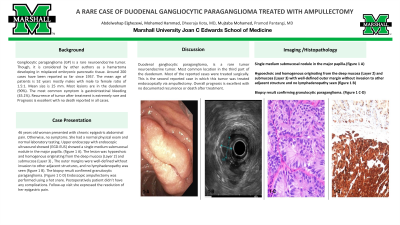Sunday Poster Session
Category: Small Intestine
P1268 - A Rare Case of Duodenal Gangliocytic Paraganglioma Treated With Ampullectomy
Sunday, October 22, 2023
3:30 PM - 7:00 PM PT
Location: Exhibit Hall

Has Audio
- AE
Abdelwahap Elghezewi, MD
Marshall University
Huntington, WV
Presenting Author(s)
Abdelwahap Elghezewi, MD1, Mohamed Hammad, MD1, Dheeraja Kota, MD2, Mujtaba Mohamed, MBBS3, Pramod Pantangi, MD1
1Marshall University, Huntington, WV; 2NTR University, India, Huntington, WV; 3Joan C. Edwards School of Medicine, Huntington, WV
Introduction: Gangliocytic paraganglioma (GP) is a rare neuroendocrine tumor. Though, it is considered by other authors as a hamartoma developing in misplaced embryonic pancreatic tissue. Around 200 cases have been reported so far since 1957. The mean age of patients is 52 years mostly males with male to female ratio of 1.5:1. Mean size is 25 mm. Most lesions are in the duodenum (90%). The most common symptom is gastrointestinal bleeding (45.1%). Recurrence of tumor after treatment is extremely rare and Prognosis is excellent with no death reported in all cases.
Case Description/Methods: 46 years old woman presented with chronic epigastric abdominal pain. Otherwise, no symptoms. She had a normal physical exam and normal laboratory testing. Upper endoscopy with endoscopic ultrasound showed (EGD-EUS) showed a single medium submucosal nodule in the major papilla. (figure 1 A). The lesion was hypoechoic and homogenous originating from the deep mucosa (Layer 2) and submucosa (Layer 3) , The outer margins were well-defined without invasion to other adjacent structures, and no lymphadenopathy was seen (figure 1 B). The biopsy result confirmed granulocytic paraganglioma. (Figure 1 C-D) Endoscopic ampullectomy was performed using a hot snare. Postoperatively patient didn’t have any complications. Follow-up visit she expressed the resolution of her epigastric pain.
Discussion: Duodenal gangliocytic paraganglioma, is a rare tumor neuroendocrine tumor. Most common location in the third part of the duodenum. Most of the reported cases were treated surgically. This is the second reported case in which this tumor was treated endoscopically via ampullectomy. Overall prognosis is excellent with no documented recurrence or death after treatment.

Disclosures:
Abdelwahap Elghezewi, MD1, Mohamed Hammad, MD1, Dheeraja Kota, MD2, Mujtaba Mohamed, MBBS3, Pramod Pantangi, MD1. P1268 - A Rare Case of Duodenal Gangliocytic Paraganglioma Treated With Ampullectomy, ACG 2023 Annual Scientific Meeting Abstracts. Vancouver, BC, Canada: American College of Gastroenterology.
1Marshall University, Huntington, WV; 2NTR University, India, Huntington, WV; 3Joan C. Edwards School of Medicine, Huntington, WV
Introduction: Gangliocytic paraganglioma (GP) is a rare neuroendocrine tumor. Though, it is considered by other authors as a hamartoma developing in misplaced embryonic pancreatic tissue. Around 200 cases have been reported so far since 1957. The mean age of patients is 52 years mostly males with male to female ratio of 1.5:1. Mean size is 25 mm. Most lesions are in the duodenum (90%). The most common symptom is gastrointestinal bleeding (45.1%). Recurrence of tumor after treatment is extremely rare and Prognosis is excellent with no death reported in all cases.
Case Description/Methods: 46 years old woman presented with chronic epigastric abdominal pain. Otherwise, no symptoms. She had a normal physical exam and normal laboratory testing. Upper endoscopy with endoscopic ultrasound showed (EGD-EUS) showed a single medium submucosal nodule in the major papilla. (figure 1 A). The lesion was hypoechoic and homogenous originating from the deep mucosa (Layer 2) and submucosa (Layer 3) , The outer margins were well-defined without invasion to other adjacent structures, and no lymphadenopathy was seen (figure 1 B). The biopsy result confirmed granulocytic paraganglioma. (Figure 1 C-D) Endoscopic ampullectomy was performed using a hot snare. Postoperatively patient didn’t have any complications. Follow-up visit she expressed the resolution of her epigastric pain.
Discussion: Duodenal gangliocytic paraganglioma, is a rare tumor neuroendocrine tumor. Most common location in the third part of the duodenum. Most of the reported cases were treated surgically. This is the second reported case in which this tumor was treated endoscopically via ampullectomy. Overall prognosis is excellent with no documented recurrence or death after treatment.

Figure: single medium submucosal nodule in the major papilla.(figure 1 A)
hypoechoic and homogenous originating from the deep mucosa (Layer 2) and submucosa (Layer 3) with well-defined outer margin without invasion to other adjacent structure and no lymphadenopathy seen (figure 1 B)
Biopsy result confirming granulocytic paraganglioma. (Figure 1 C-D)
hypoechoic and homogenous originating from the deep mucosa (Layer 2) and submucosa (Layer 3) with well-defined outer margin without invasion to other adjacent structure and no lymphadenopathy seen (figure 1 B)
Biopsy result confirming granulocytic paraganglioma. (Figure 1 C-D)
Disclosures:
Abdelwahap Elghezewi indicated no relevant financial relationships.
Mohamed Hammad indicated no relevant financial relationships.
Dheeraja Kota indicated no relevant financial relationships.
Mujtaba Mohamed indicated no relevant financial relationships.
Pramod Pantangi indicated no relevant financial relationships.
Abdelwahap Elghezewi, MD1, Mohamed Hammad, MD1, Dheeraja Kota, MD2, Mujtaba Mohamed, MBBS3, Pramod Pantangi, MD1. P1268 - A Rare Case of Duodenal Gangliocytic Paraganglioma Treated With Ampullectomy, ACG 2023 Annual Scientific Meeting Abstracts. Vancouver, BC, Canada: American College of Gastroenterology.
